

|
Home Updates Hydros Cars Engines Contacts Links SS100 Replica |
Russell SS 100
|
|
The 1942 Christmas issue of the Aeromodeller carried an illustrated description of D A Russell’s replica of his own 2-½-litre two-seater SS100. Russell being a scale fan and the SS100, of which he owned three during his lifetime, being his favourite car, it followed that he should use it as the prototype for his own model car. SS Cars was originally set up as Swallow Sidecars in 1922 by William (Bill) Lyons and William Walmsley. The company changed its name to SS Cars in 1933 and to the name it is still known by, Jaguar, in 1935. The SS100 was produced at Coventry from 1936 to 1940 and cost £395 in 1937. The 2.5 litre version was capable of 95mph with the windscreen lowered. D A Russell's SS100 photos courtesy of Shirley Russell |
|
Russell’s smaller version was built following the launch in Aeromodeller of the competition for model racing cars. Mr Galeota’s car plans had also been published around the same time and sparked a lot of dissatisfied muttering from among the aero modelling enthusiasts about cars in 'their' magazine. Russell did publish a separate magazine called ‘Model Cars’ in 1946 but up till then the odd article on tethered cars continued to appear in the Aeromodeller. Painting by Norman Giles of DAR driving his own SS100. Courtesy of Edwin Russell |
|
|
|
Russell’s SS100 is a very large model as the scale was determined by the size of wheels that could be obtained. Being wartime the only tyres that were commercially available were ‘ashtray’ advertising tyres produced by various companies. Russell used a set from The India Tyre and Rubber Company that measured 5 ¼ inches in diameter. Comparing these with the full sized ones, a scale of 1 in 5 was arrived at. This gave an overall finished length of 29 ½ inches, width 7 ¼ inches, wheel base 19 inches and track 9 ¾ inches. A very large model. Left: D A Russell running the car at Eaton Bray |
The description of the model in Dec 1942 gave a great deal of detail about the design and construction, although the drive-train and back axle were extensively reworked before the plans were published. The chassis followed the design of the original, being upswept over the front axle and tied with x bracing. The side members were of birch and three-ply as was the cross bracing. This was then glued and nailed together. In his build notes Russell, or DAR as he came to be known, commented that this gave a light but very strong frame that was capable of withstanding considerable strain. ‘When assembled, and being supported at each end the chassis will bear the weight of a child standing in the centre’. In 1947 he observed that ‘this construction has withstood several seasons of high-speed running and although a chassis of this type will flex to a certain extent, this flexure is a characteristic of the prototype and is allowed for in the design of transmission and universal joints’.
The back axle was silver steel rod mounted in ball races. These ball races being enclosed in soft India rubber contained in sheet metal casings, secured by bolts to the chassis mainframe. At this stage the gearbox was a simple open metal frame with two equal bevel gears. Unlike most later cars and the SS in its later form there was a simple spur-gear reduction from the engine to drive-shaft which was attached to the chassis member just behind the fly wheel. This had a ratio of 1.35:1. Both gearbox and reduction unit were built by Aeromodeller staff member Stan Rushbrooke.
There are two front axles to allow the wheels to be inclined at the correct chamber. The outer ends of the front axles were also carried in ball races, which could be moved backwards, and forwards underneath the dumb-irons to allow the front wheels to swivel slightly for round the pole running. In total the car had 15 ball races fitted, twin pairs in the back axle, four in the bevel gear box, three in the reduction gear box and four carrying the front axles, designed to keep the ‘internal’ friction to a minimum. Half-elliptic springing as on the original, was claimed to work well making the car steady at speed. The spring although giving a realistic appearance was not quite what it seemed. The master leaf was the spring while the secondary leaves were false, being constructed of plywood.
|
|
In June 43 DAR stated that the car was fitted with a 10cc Dennymite engine, yet all the contemporary photos show a Brown Junior. A later article confirms that it was ‘a faithful Brown Junior that had seen considerable flying service before being installed in the SS’. This in turn was replaced by an Ohlsson 60 running on petrol. Transmission was via a centrifugal clutch designed and made for DAR by Bob Curwen, who also made the back axle casing. DAR stated that the centrifugal clutch allowed the engine to be run ‘free’ at speeds of up to 1500rpm, but provided a solid drive from 2000 rpm upwards. |
The body of the car was built by W.A. Dean of the Aeromodeller from balsa mounted on a 1/8th ply base, strengthened appropriately with ply and birch strips. The bonnet of 1/16th ply was a work of art with each of the 246 louvres being individually shaped and glued into position by another Aeromodeller staff member, 16 year old B. Alder.
The weight of the car, at just over 12lb, has the drive, as in the original, being through the rear wheels. Just behind which the battery is mounted, in the position occupied by the petrol tank in the full-size car, providing plenty of weight on to the driving wheels. DAR went on to say that he had been running the car on a grass lawn and had obtained speeds of around 40mph. He later planned to change the gear ratio to approximately 1.35 to 1 at which the car should do 60mph, with an engine speed of 5000rpm. One suspects that this is theoretical as no cars were achieving that sort of speed at the time, especially not one as heavy as the SS.
The car appeared and ran for some time with a set of plain disc wheels, machined from scrap aluminium pulleys before these were replaced by scale, spoked versions. The scale wheels were built-up from wire spokes mounted on aluminium discs and rims to which the tyres were then added. In a later description the wheels are referred to as ‘centre locking Rudge wheels’, although this was not quite true. It was explained that the secret to the realistic- looking wheel was the fact that the spokes carried no load at all as they were dummies. The brake drum that can be seen through the spokes is utilized as the actual load-carrying wheel disc. The brass hub and spokes are added afterwards, and give every appearance of reality’. DAR called this making a ‘fine compromise’.
|
A scale steering wheel, seats and an instrument panel with all the dials marked to scale, completed the build. DAR hoped to have a scale driver and mechanic sitting in the car but that never came about. The bodywork was finished in light ‘crystal’ green as were the wheel spokes, while the chassis was painted black all over. The interior and seats were covered with thin red leather. The SS was one of the seven early cars that was publicised by Russell and the Drysdale Press in the ‘Model Race Cars’ book published in 1945. |
|
Plans for the car were available at 18/6, which were the most expensive of the seven. By the time ‘Model Cars’ magazine was published in 1946, the SS had undergone several modifications including the fitting of the Ohlsson motor. A new beam front axle with full Ackermann steering and adjustable track rod was fitted to allow the steering to be adjusted for different sized tracks. With all these alterations the speed had increased by around 10mph and over 50mph had been achieved in this form. In issue # 2 of ‘Model Cars’ in Nov 46 the SS features as the model of the month with a full description and a double page cutaway drawing by Laurie Bagley.
|
|
There is evidence that the car was run regularly and certainly appeared at the early Eaton Bray meetings. 1947 seems to be the last year that it was run in competition where it featured in all the major events at Eaton Bray, often being run by E Wonnacott. It’s speed varied between 42 and 45 mph. In the 1947 running of the Russell Trophy that combined scale points and speed it came 2nd only to Gerry Buck’s 2A but was not officially placed being Russell’s own car. Again it was run by Mr. Wonnacott, who is seen holding the car here, and in other photos published in various Drysdale publications. Whether Russell’s magnificent SS survived is not known although there have been other models made from his plan. The latest being a superb example from Gary Maslin who set himself the task of building all seven of the pioneer cars featured in the Drysdale plans list. Having already completed the Galeota, the Russell SS100 can also be crossed off that list. Gary has very generously shared the ups and downs he encountered during the build. |
‘Maslin’ SS100
|
After the completion of the Galeota car I decided to move on to the large scale Russell SS100, the main reason for this is that I had been able to acquire, through Ebay, the correct ash tray tyres in lovely condition as illustrated on page 42 of the Drysdale Press, Motor Racing in Miniature book of 1947. Before I commenced the build I made sure I had all the parts required to complete the car. Like all of the early cars, the count of commercially produced items in the SS is very low, for the simple reason that there were none. With the exception of the motor and associated electrics, everything else had to be made from scratch or adapted from other uses. Russell used a set of advertising tyres, along with a clutch and gearbox made for him by Bob Curwen. Gary started with a similar selection of bits for his mammoth build which was to represent the car in its final guise as seen above in the Bagley drawing. |
|
As the car went through various stages in its life I had to make a decision as to which version I would go for. After studying all the magazines, photo’s, articles and books of the time I went with the model as it appeared near the end of it’s documented racing life. A lot more lathe work would be involved, (having just acquired a Myford ML 7 that was first used in anger on the Galeota) but the end result would be a much more pleasing and realistic model compared to it’s first published form. It is featured in the Aero Modeller of December 1942 showing open bevel drive, solid disc alloy wheels, fixed steering and powered by a Dennymite engine.
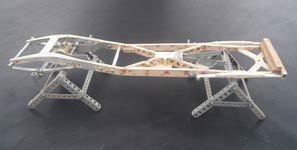 |
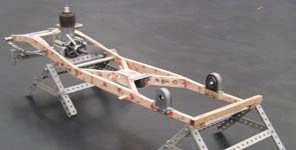 |
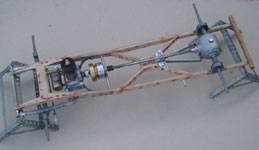 |
The build was commenced towards the end of 2007 a few weeks after the completion of the Galeota, the chassis was built as in the plan (obtained through the Retro Racing Club) The Ohlsson & Rice 60 engine mounted as shown, the original attached tank was removed and a new one made and soldered up as in plans, made up from copper tube 32mm dia with brass end caps and shaped collar drilled and tapped for the fuel filler nut along with the fuel tube entry hole. The tank was fitted with soldered tinplate straps and was bolted to the round cross member forward of the engine mounting. The centrifugal clutch and flywheel is of the 1066 design, being a perfect fit in the available space within the chassis, the drive end of the clutch is a slot and pin type driving a 5/16"dia steel prop shaft mating with an identical union at the gearbox.
The gearbox is to the plan dimensions machined from one piece of aluminium alloy, with a end plate of the same material, fixed by 8 x 6ba bolts and gasket. Internally the gearbox is a fully ball-raced differential with oil seals, as the gearbox is oil filled. This is a departure from the original design but I could buy the full differential set-up for less than the price of the 2 bevel gears! As the unit fitted within the exterior gearbox dimensions, and of course differentials gears had been used in full sized cars for a considerable time, I allowed myself that luxury!
The drive to the rear axles is the same arrangement as used for the prop shaft the gearbox is braced by a 1/16"x ½" mild steel strip to the centre chassis rails by a rubber block as shown on the plan detail. The rear axles are mounted in ball races set in rubber blocks mounted to the chassis rails in mild steel housings again exactly as shown on the plan, just to be a bit more in keeping with my use of period materials all the rubber was cut from original full size 1940s Hillman Minx engine mounts! I didn’t have any SS100 Jag ones lying about!
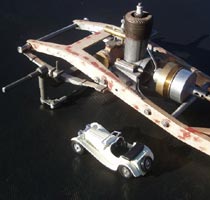 |
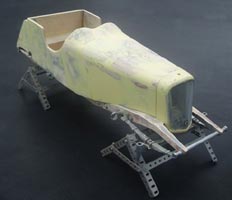 |
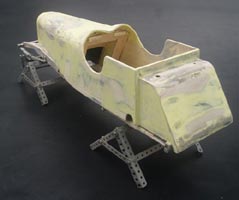 |
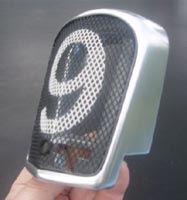 |
As the plan only showed the early fixed front axle design, I copied the details and arrangement shown in the cutaway drawing on page 42 in the 1947 ‘Motor Racing In Miniature’ book, the springs are of tempered mild steel bolted to the beam axle cut from ¼" mild steel plate with the same steel used for the springs formed and soldered to top and bottom to create the beam section, time consuming but it looks right. 5/16" dia. king pins carry the ¼" dia. stub axles, the adjustable 1/8"dia. tie rod is mild steel and of a conventional design using left and right hand threads for adjustments!
The original car was built with traditional bodywork of aluminium sheet over an ash frame. The model's body was all wood with mocked-up detailing. Gary has stayed true to the methods with this complex ply shape. The radiator cowl and grill are a work of art on their own. True to prototype, each of the louvres has been made and attached individually, rather than punched as would have been done on the full sized car, and a rough count gives 232. That is serious attention to detail. The chassis is painted and the body just awaits the top coat when a final decision is made about the colour.
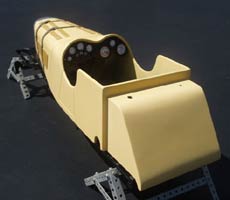 |
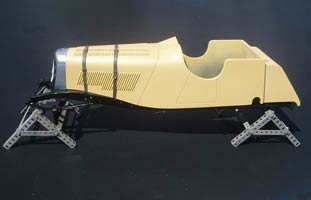 |
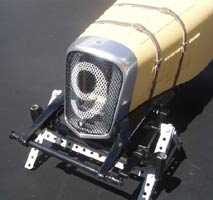 |
The major task remaining is building the wheels and here Russell's original started with a set of disc wheels before the more complicated spoked versions were fitted. Reproducing the wheels represents a monumental task as each dummy brake drum and hub have to be machined from aluminium bar. Although the spokes are only dummies there are still 48 of them in each wheel, requiring 96 accurately drilled 1mm holes.
|
Gary continues the story:- The first completed wheel and tyre. Each wheel consumes 6 feet of 1mm stainless steel hard dental wire. (not including the ones that nearly had my eye out and are still hiding in the workshop somewhere)! |
|
|
|
|
The chassis having had its final coat of ‘chassis black’ was ready for the electrical side to be fitted, coil, condenser, HT circuit along the same lines as my previous build the ‘Galeota special’ using 1940’s cloth braided wire. The booster sockets for an external battery are located in the floor behind the front nearside seat. The cut off lever does not follow the generally favoured position of rising vertically, but is telescopic, extending horizontally at 90 degrees from the underside of the chassis when in use. The cut off lever and switch is again made from period materials, in this case the switch contact is a polished spring steel paper holder, the cut off lever itself is fashioned from an ex WD nickel plated veterinary needle circa 1944 (printed on the box). |
|
The battery box is as plan, built with 1/8 inch ply and ¼ inch balsa housing 3 x 1.5 volt batteries. The lid has a small bakelite knob from an old radio, the electrical connections are thin brass sheet with wiring soldered directly to them. The chassis was then completely finished, with the wheels and tyres being fitted and all the bearings, axles etc checked to ensure everything lined up and did what it was supposed to. |
|
|
|
To maintain authenticity to the original as much as possible the original fuel tank was discarded, and a new one made from 32 mm dia. copper tube, 42mm in length with flush soldered end caps, mounting bands and screwed hex head filler cap. These are the dimensions on the drawings and appear to be confirmed by contemporary photos. I have serious doubts that the car could cover more than a few laps of a track of equal size to the Eaton Bray track. Russell eventually replaced the fuel tank with a dummy and used the Ohlsson plastic tank. |
|
After much deliberation I decided on the body colour of light British racing green. The actual paint job itself consisted of two coats of satin black cellulose to the underside of the bonnet and bodywork. The BRG body colour was applied in seven coats rubbed down, in between coats, with 1200 grade wet and dry. Final polish achieved with TCut and Auto Glym polish. |
|
|
|
The upholstery and interior trim. The floor rubber, ( made from replacement running board rubber for full size 1934 Hillman Minx). Seats (balsa trimmed with real leather). Trim panels (leather over 1/16" ply). Transmission tunnel (1950's motor cycle over balsa). The cut out in the floor panel matches the rubber on the chassis on which are mounted the battery booster sockets and switch. |
|
I then fitted with the previously completed items: leather seats, leather trim, door handles, grab rail, steering wheel, ribbed floor mats, transmission tunnel and instrumentation. The steering wheel was made up with brass plate and a 1/8 diameter brass rod. A dry run was carried out to make sure no silly mistakes had been made before being glued into position. The gear lever knob was made from a pearl from an old necklace, painted black. The hand-brake lever was fashioned from another nickel plated veterinary needle, the end fitting on the syringe having a pleasing handle shape, finished off with a dome-head black iron rivet glued onto the end to represent the hand-break release button. |
|
Overall, I am pleased with the outcome, it had never been intended for this car to be a true scale model of the Gerald Wingrove quality, but to be as faithful as possible to Russell’s original model.
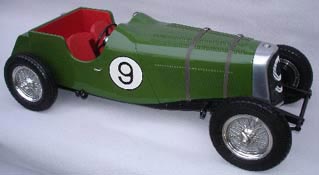 |
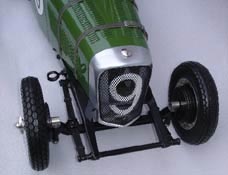 |
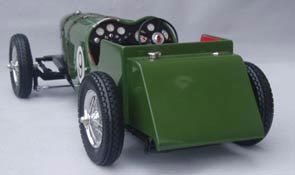 |
What none of
the photographs convey is any concept of the scale of the car. It is half as big
again as most tether cars
measuring just on 30 inches long. The images below of
Gary with the car reveals the true size of the SS100.
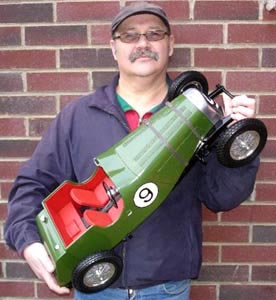 |
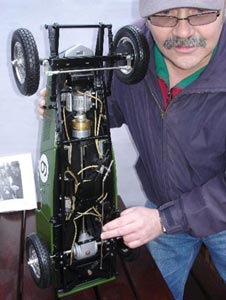 |
Text and photo's Thea and Gary Maslin.
Through debillitating physical problems and a total change in collecting interest to the pursuit of CIJ Alfa Romeo cars Gary's project to build replicas of all seven of the pioneering designs stalled after just three superb examples, the SS100 being passed on to another member of the Retro Club.
©copyrightOTW2009